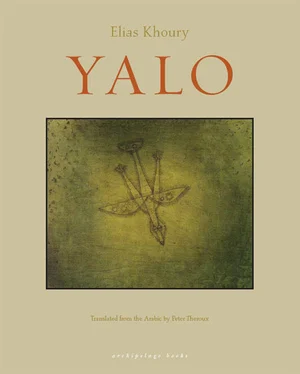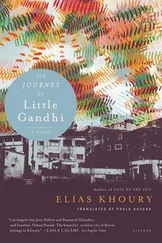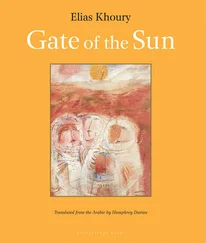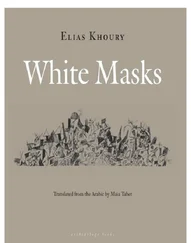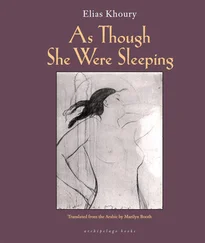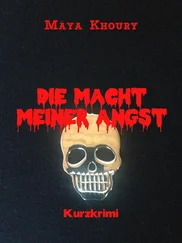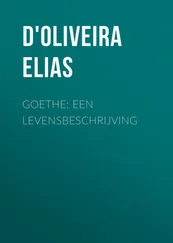The image began with the color black, soon replaced by white. The dress became white and blood spread into its folds, as if the blood were tracing the fetus’s head and its stupified expression in the face of death, while the woman’s face was indistinct, as if covered by a pale yellow stain.
The woman emerged from the wall and started rushing through narrow streets. Suddenly the streets vanished and the woman was alone in the wilderness before she reached the outskirts of the city of Tyre. She stood before a walled structure. She knocked at the gate and a nun opened it, then slammed the iron gate in her face. But the white, bloodstained dress sounded again, emitting a noise like the cry of a baby. The nun reopened the gate, grasped the woman by the arm, and brought her into the convent.
The morsels of the story Yalo had heard from Nina the Russian became a picture on the wall of his cell. At night, the picture came off the wall and rushed off in search of the convent of Russian Orthodox nuns in Tyre that would take her in with her fetus crying in her belly, and that would save its life and hers.
Yalo couldn’t remember the story in a coherent manner. Nina gave the name of the village, and told how the man had been slaughtered, his head upon his wife’s belly, but now Yalo couldn’t remember the name, nor did he know how to explain what happened in 1860, in the massacre that inaugurated a chain of massacres throughout Lebanon. They said that when the Russian Orthodox nun heard the crying of the fetus in the pregnant woman’s belly as blood flooded around it, she went into a stupor. She had no choice but to reopen the gate and allow the woman to stay at the convent, where she gave birth to her only daughter.
“That girl was my great-grandmother, and they used to call her the Muscovite because she was born in the Russian nuns’ convent in Tyre. Her children and grandchildren were called the children of the Muscovite. That became our name.”
What happened on that hot July day in 1860?
Yalo drew a picture of the village in his mind and called it “Nina’s town.” There in the village that slumbered on the slope of Mount Hermon began the massacre in the house of the woman in her sixth month of pregnancy.
A man with a rifle came in and told the pregnant woman’s husband that he was his friend, so he would be the one to kill him, rather than letting anyone else torture him before killing him. He placed the man’s neck against his young, pregnant wife’s belly, and slaughtered him with a knife, like a sheep. The blood spurted and penetrated the woman’s insides, and she lost the power of speech. She ran out of her house, to find herself in the convent of Russian nuns in Tyre, where she gave birth to her daughter.
Before the story got to the part about the rich man who asked the abbess for the orphan girl, who died leaving a huge fortune to her and her daughter, there were many things that needed clarification. But Yalo did not dare tell Nina that it was hard to swallow the story of the man placing his head on his pregnant wife’s stomach before being slaughtered, or that some of the things said to have been said sounded more like something from a novel or a movie than like something that had really happened.
Yalo was certain that over the course of this war the Lebanese had dug up the history of all their past wars to justify their madness, which made talking to them impossible. It was true that he himself behaved like a Lebanese during the war, and he was Lebanese and wouldn’t allow the interrogator to trick or threaten him with his father who was not his father and whom he had never known. Yalo had fought under the banners that had been raised, and swallowed everything he was told, but when Nina the Russian told him about her grandmother, he felt that he had taken in too many stories and couldn’t bear it any longer. Nina told the story as if she had been an eyewitness, and even repeated the same words the killer spoke at the moment he committed his crime.
“You’re my friend, I’m the one who’s going to kill you. Don’t be afraid. You won’t feel anything, just a little hornet’s sting.”
She said that the killer said “hornet’s sting” and that the night before the crime he’d come to the house of the victim and reassured him, saying that nothing would happen in their village, that their coexistence there was sacred. The man slept reassured despite the smell of fear that pervaded the village. The next morning he heard a knock at the door, opened it, and beheld the face of death. Suddenly the man was struck with horror and never uttered a word. He bowed his head, laid it against his wife’s belly, and died.
“A hornet’s sting,” he said before taking the knife and slashing the neck upon the belly of the pregnant wife who had not yet turned seventeen. Then he left, leaving the young woman to wander like a madwoman for days and days on country roads before arriving at the Russian nuns’ convent.
“It couldn’t have happened that way,” thought Yalo, as he watched the woman emerge from the wall with her distended belly, as she began running toward the convent in Tyre.
She knocked, and the nun opened the iron gate a crack. When she saw the round belly stained with blood, she slammed the gate shut.
She knocked again, and the fetus cried in her belly.
Nina said that had the Russian nun not heard the sound of the fetus’s crying coming from the woman’s belly, she would not have opened the door a second time.
“The fetus cried in its mother’s belly,” said Nina.
“Is that possible?” asked Yalo.
“Of course it’s possible, my son. It was a miracle, and the proof was that the nun was a saint. The other nuns began to kiss the nun’s hand that opened the door, because she’d heard the voice that no one but Elisabeth had heard. No one but a saint can hear the voice of a fetus.”
“But maybe it’s your grandmother who was the saint, because it’s the fetus in her belly that spoke,” said Yalo.
“No, my son, that wasn’t my grandmother, that was my great-grandmother. She didn’t hear the fetus crying in her belly, because God didn’t open her ears to it. Only divine intervention can open ears.”
Yalo said that he understood, but in fact he didn’t understand a thing. The young woman had fled her village and taken shelter at the convent, where she gave birth to her baby girl, and they lived there together, the mother serving and the young daughter studying. When the girl turned fourteen, the gentleman Nakhleh Sadeq met her; he was a Tyrian merchant of fifty who had emigrated to Argentina and come to Lebanon to marry and then return to his new country. He saw the girl once in front of the convent and fell in love with her. He asked her mother for her daughter’s hand, but she refused to discuss the matter with him. She said that she and her daughter belonged to the convent and that he had to speak with the abbess. The abbess summoned the girl, feeling certain that she would refuse the marriage — being the child of the miracle — that she would choose a vow of chastity and become a bride of Christ. So the abbess was surprised to see the girl agree to the marriage. Her conditions were that her mother should live in the house with them, and that Mr. Nakhleh not return to Argentina. The even greater surprise was when Mr. Nakhleh agreed to both conditions. The rich merchant married the girl, and she gave him her only son, Musa.
“That is how we became the Musa family, only everyone called us the children of the Muscovite,” said Nina.
“So you are not White Russians,” said Yalo.
“Our hearts are white and we love Russia,” said Nina.
Yalo saw the young woman emerge from the wall with her distended belly, whose bloodstains had taken on the shape of a fetus attached to its mother’s belly. The mother rushed into the forest and hid behind the first pine tree she found, then got up to run toward the convent of Russian nuns.
Читать дальше
